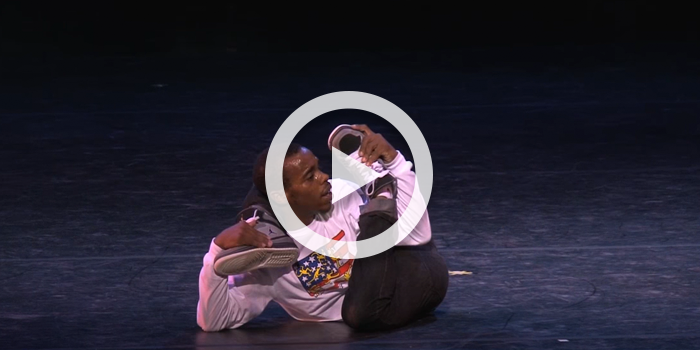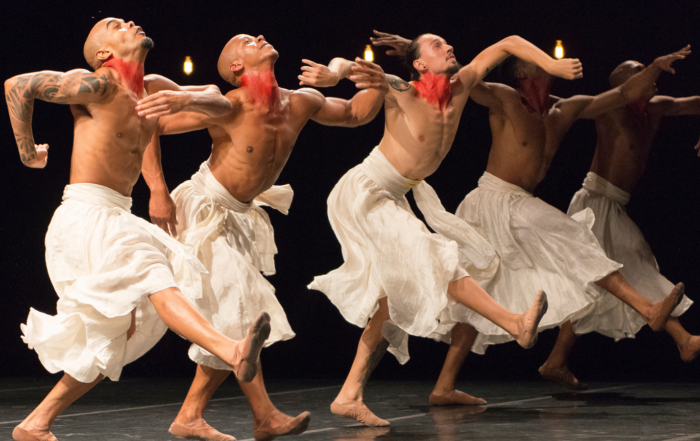In this issue: Choreographer Bintou Dembélé revamps Les indes galantes; Ustad Amjad Ali Khan’s performance at the 2014 Nobel Peace Prize Concert; Blind Willie McTell’s “Statesboro Blues”; soprano Karita Mattila performs Sibelius’ “Flickan kom ifrån sin älsklings möte”; Astor Piazzolla and Friends perform “Libertango”; violinist Aleksey Igudesman and pianist Hyung-ki Joo perform “I Will Survive”
Now, More Than Ever: Issue 21
Rameau: “La danse du Grand Calumet de la Paix” from Les indes galantes
Bintou Dembélé, choreography
Judging from the critical response, last year’s production of Rameau’s opera Les indes galantes (The Amorous Indies,1735) at Paris’ Opéra Bastille was a huge success for all concerned, including conductor Leonardo García Alarcón and his Cappella Mediterranea, the Choeur de Chambre de Namur, and a cast that featured vocalists Sabine Devieilhe and Florian Sempey (heard in this clip). But I want to draw your attention to the phenomenal choreographic contributions of Bintou Dembélé, a pioneering figure in French hip hop dance, and the members of her electrifying company Rualité.
It won’t come as any surprise that an opera about the encounter between the French Enlightenment and an often stereotypical cast of Persian, Turkish, Peruvian, and Native American characters—not to mention a final section called “The Savages”—might have more than a few challenges to meet when mounting a production for contemporary audiences. Here, the addition of Dembélé’s red-hot dance movements—a thrilling mix of krump, vogue, break, electro, and flex—seems the perfect solution for updating the proceedings and adding a dash of relevancy. As Zachary Woolfe wrote in the New York Times:
The climactic dance… remains, as it was in the 1730s, a thrilling presentation of what will be, for many in the audience, a foreign style, celebrated for its foreignness—here, an escalating, showstopping detonation of krump. But the sequence is now also an assertion of the fullness, the sufficiency, of the community performing it. These “others” don’t need the white gaze to exist; they meet that gaze, and go on dancing.
Make sure to stick around for the applause at the end. This is truly what the expression “bring down the house” means.
“Raga for Peace”
Ustad Amjad Ali Khan
Ustad Amjad Ali Khan’s presence at the 2014 Nobel Peace Prize Concert—which honored Pakistani activist Malala Yousafzai and Indian social reformer Kailash Satyarthi “for their struggle against the suppression of children and young people and for the right of all children to education”—made for a particularly satisfying and resonant occasion. Among the brightest stars in the Indian classical music firmament, the great sarod player—seen here with sons Amaan Ali Khan and Ayaan Ali Khan and tabla player Satyajit Talwalkar—dazzles in an atypically short raga (these pieces can go on for upwards of an hour). I love the virtuosity on display here, the “anything you can do, I can do better” spirit that lifts this music to the heavens.
Blind Willie McTell: “Statesboro Blues”
Featuring Taj Mahal and Ry Cooder
The Piedmont blues song “Statesboro Blues” was written by Blind Willie McTell, who recorded it in 1928. (“I’m gazing out the window/Of the St. James Hotel/And I can tell you one thing/Nobody can sing the blues/Like Blind Willie McTell,” sang Bob Dylan). Taj Mahal covered the song 40 years later, a version so popular it inspired yet another successful recording, this time by the Allman Brothers Band. The Allman Brothers version is ranked number nine on Rolling Stone’s list of the “100 Greatest Guitar Songs of All Time,” and 15 years ago, the Atlanta Journal-Constitution ranked “Statesboro Blues” number 57 on its list of “100 Songs of the South.”
What led me to “Statesboro Blues” was a YouTube search for Ry Cooder, both an accomplished performer and a renowned producer, with a love of and fascination for all kinds of music. He produced the legendary Buena Vista Social Club recording, which in the 1990s led to the increased international appreciation of traditional Cuban music and revived the careers of many fine musicians from that island nation. Life has its surprises, and I love the fact that Ry Cooder led me to Taj Mahal, and to a great recording!
Leading the band, Mahal is in magnificent form here, reminding us that the blues need not be sad. This memorable jam session is a pure joy!
Sibelius: “Flickan kom ifrån sin älsklings möte,” Op. 37, No. 5
Karita Mattila, soprano
Esa-Pekka Salonen, conductor
Swedish Radio Symphony
We first encountered this superb Sibelius song way back in March, Issue 2 of Now, More Than Ever, in a lovely performance by mezzo-soprano Jamie Barton, but it’s such a treasure that it deserves another look, especially in the hands of the great Finnish soprano Karita Mattila. This video comes from conductor and incoming San Francisco Symphony music director Esa-Pekka Salonen’s 50th birthday concert in 2008, when Mattila was at the height of her powers. Just watch how the expression on her face changes before the last verse. Her absolute commitment to the piece jumps through the screen, as does the beauty of her voice and her unique personal magnetism.
Sibelius normally didn’t like his songs to be orchestrated—he wrote this one with piano accompaniment—but if they were going to be, he preferred to do it himself. This is the composer’s own arrangement, and I think the larger orchestral palette pulls you into the drama. Sibelius wrote many great songs and I promise that we’ll get to more of them soon.
Piazzolla: “Libertango”
Astor Piazzolla and Friends
Fair warning: if this video at first seems rather odd (to say the least, given its weird 1970s sensibility), don’t worry; my reason for including it will be revealed about halfway through, when the great Astor Piazzolla takes center stage. Initially a renowned figure in pop music, Piazzolla ultimately achieved fame as a serious composer and the primary advocate for the nuevo tango movement of the 1980s. This is perhaps his most famous composition, a piece that’s almost single-handedly responsible for the elevation of tango music to music for the concert hall.
Before discovering this video, I had never seen Piazzola play the bandoneon—an instrument we rarely encounter these days, at least in this country—but he’s clearly an accomplished virtuoso. I’ve listened to “Libertango” arranged for many combinations of instruments—violins, violin/piano, 12 cellos, and a memorable a cappella version by the Swingle Singers, to name a few—but this may be my favorite performance, given its deeply diabolical and sensuous qualities.
“I Will Survive”
Aleksey Igudesman, violin
Hyung-ki Joo, piano
Since June is Gay Pride Month, I thought I’d leave you with this delightful take on my favorite Pride anthem, “I Will Survive,” the 1978 Freddie Perrin/Dino Fekaris hit immortalized by Gloria Gaynor. I’d say more, particularly concerning the eccentric chemistry between violinist Aleksey Igudesman and pianist Hyung-ki Joo, but somehow, I think words are superfluous, certainly in this case. Enjoy!
Now, More Than Ever Full Playlist
Now, More Than Ever Spotify Playlist








